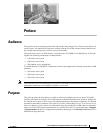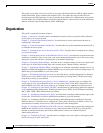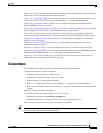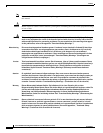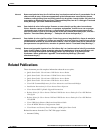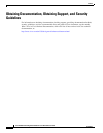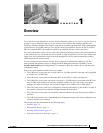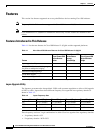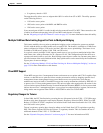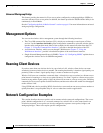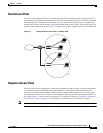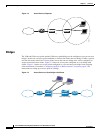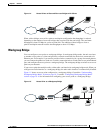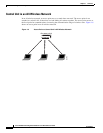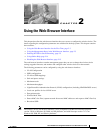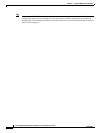
1-3
Cisco IOS Software Configuration Guide for Cisco Aironet Access Points
OL-11350-01
Chapter 1 Overview
Features
• U regulatory domain = W52
The upgrade utility allows users to migrate their 802.11a radios from J52 to W52. The utility operates
on the following devices:
• 1130 series access points
• 1200 series access points with RM21 and RM22A radios
• 1240 series access points
Users must migrate all 802.11a radios in their wireless network from J52 to W52. There cannot be a mix
of radios in the network operating in the J52 and W52 bands because of overlap.
See the “Migrating to Japan W52 Domain” section on page 5-37 for more information about this utility.
Multiple VLAN and Rate Limiting Support for Point-to-Multipoint Bridging
This feature modifies the way point-to-multipoint bridging can be configured to operate on multiple
VLANs with the ability to control traffic rates on each VLAN. The feature is available on 32 Mb access
points configured as bridges (1240 series) and the 1300 series access point/bridge. The feature is not
available on 16 Mb access points (1100, 1200, and 350 series)
In a typical scenario, multiple VLAN support permits users to set up point-to-multipoint bridge links
with remote sites, with each remote site on a separate VLAN. This configuration provides the user to
separate and control traffic to each site. Rate limiting ensures that no remote site consumes more than a
specified amount of the entire link band width. Only uplink traffic can be controlled by the FastEthernet
ingress ports of non-root bridges.
See the “Configuring Multiple VLAN and Rate Limiting for Point-to-Multipoint Bridging” section on
page 5-39 for more information on this feature.
Client MFP Support
Client MFP encrypts class 3 management frames sent between access points and CCXv5-capable client
stations, so that both access point and client can take preventative action by dropping spoofed class 3
management frames (management frames passed between an access point and a client that are
authenticated and associated). Client MFP leverages the security mechanisms defined by IEEE 802.11i
to protect class 3 Unicast management frames. The unicast cipher suite negotiated by the station in the
(re)association request's Robust Security Network Information Element (RSNIE) is used to protect both
unicast data and class 3 management frames. access points in workgroup bridge, repeater, and non-root
bridge modes must negotiate either TKIP or AES-CCMP in order to use Client MFP.
Regulatory Changes for Taiwan
In June 2006, the FCC finalized rules governing the use of frequencies in the 5.250 – 5.725 GHz range.
Products using these frequencies must employ Dynamic Frequency Selection (DFS). With Cisco IOS
Release 12.3(8)JA, FCC DFC compliance was enabled in the North American domain for 1130, 1200,
and 1240 series access points.
Taiwan’s regulatory agencies have elected to adhere to the United State’s FCC regulations regarding
DFS. This release supports DFS for the Taiwan (-T) regulatory domain. This also enables the use of
additional channels in the 5.250 – 5.725 GHz band.
See the “Dynamic Frequency Selection” section on page 6-17 for more information on DFS.



